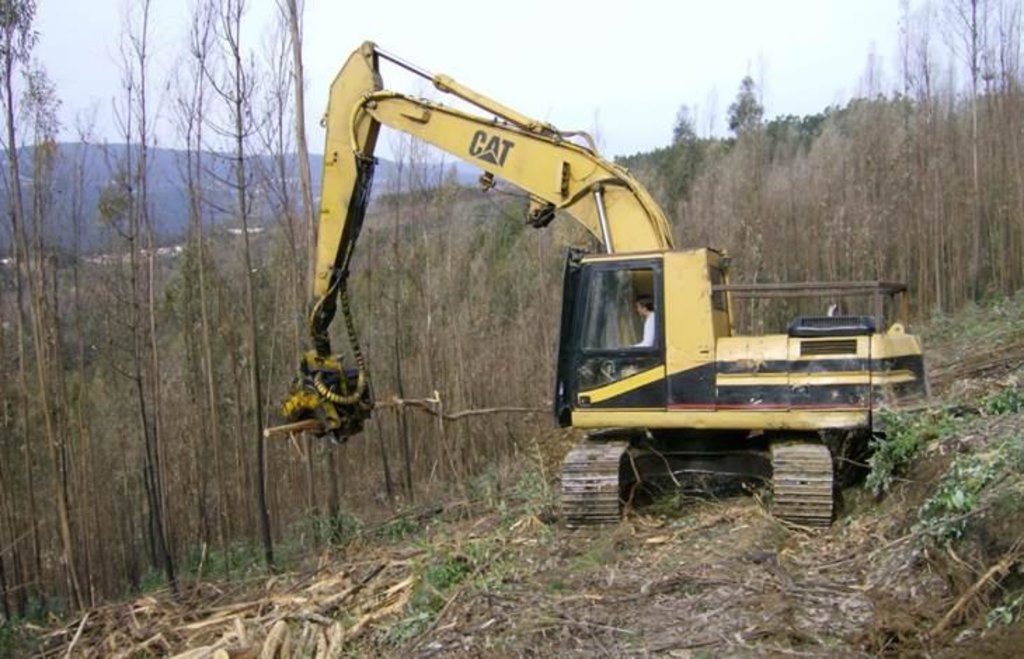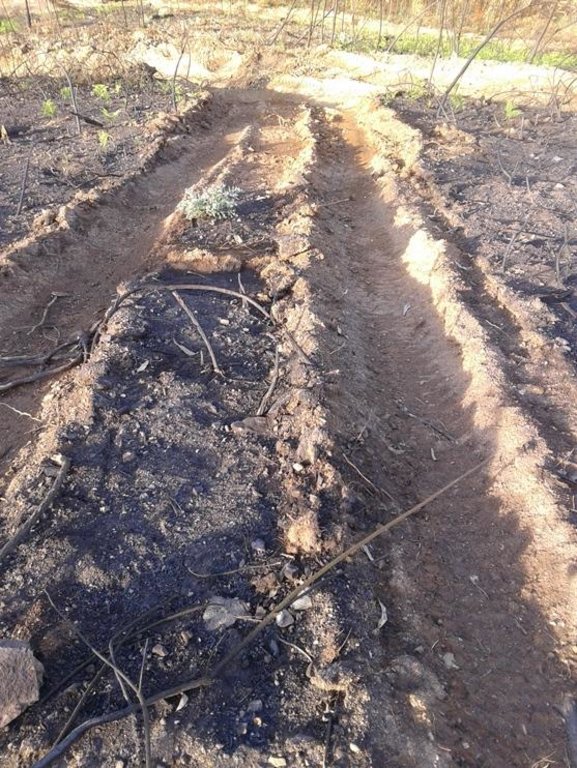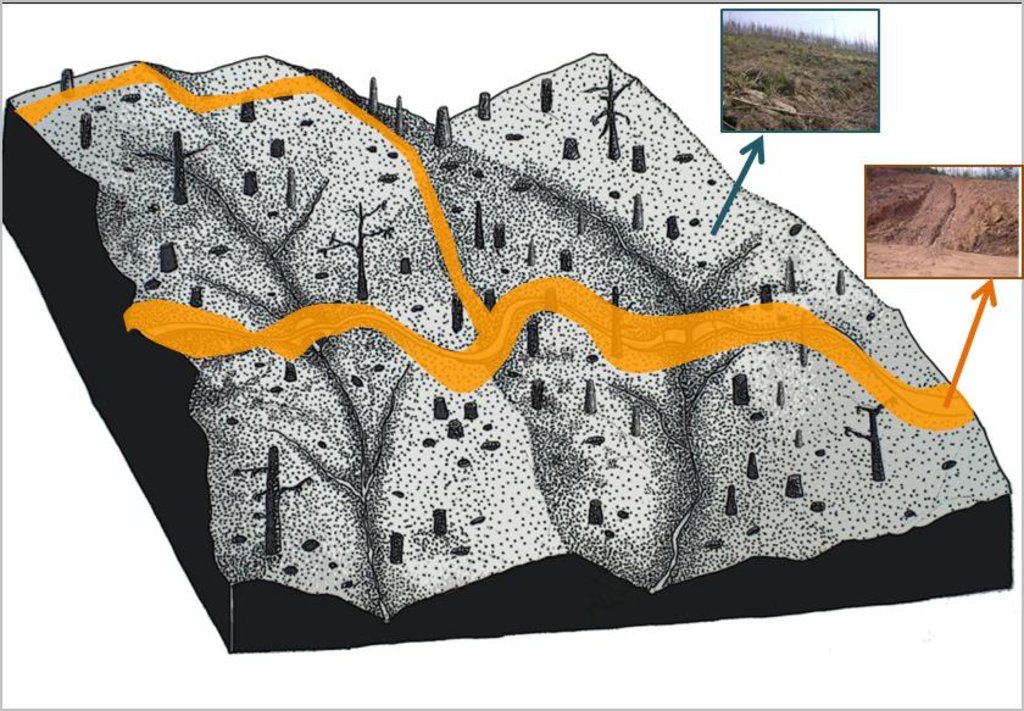Post-fire salvage logging; post-fire traditional logging [Portugal]
- Creation:
- Update:
- Compiler: Maruxa Malvar Cortizo
- Editor: –
- Reviewers: Fabian Ottiger, Alexandra Gavilano
Extração material lenhoso pos-incêndio
technologies_1713 - Portugal
View sections
Expand all Collapse all1. General information
1.2 Contact details of resource persons and institutions involved in the assessment and documentation of the Technology
SLM specialist:
SLM specialist:
SLM specialist:
Keizer Jan Jacob
Centre for Environmental and Marine Studies (CESAM) - Department of Environment and Planning-University of Aveiro
Portugal
Name of the institution(s) which facilitated the documentation/ evaluation of the Technology (if relevant)
University of Aveiro (University of Aveiro) - Portugal1.3 Conditions regarding the use of data documented through WOCAT
The compiler and key resource person(s) accept the conditions regarding the use of data documented through WOCAT:
Yes
2. Description of the SLM Technology
2.1 Short description of the Technology
Definition of the Technology:
Post-fire salvage logging is the practice of harvest the trees after fire, the employed methodology is clearcutting which involves the cut of essentially all the trees and the removal of logging residues.
2.2 Detailed description of the Technology
Description:
In the 2015 summer a wildfire affected the Semide mountain range nearby the Lousã massif, central Portugal. The area was afforested with eucalypt and pine plantations during last XX century and nowadays landscape is composed mainly by eucalypts at different stages of development and, the understory shrub vegetation.
The research team of the University of Aveiro set up an experiment to test the effect of post-fire logging in soil erosion and other selected soil properties.
Purpose of the Technology: Post-fire logging is a common management practice usually undertaken to recover burnt timber resources, to plant new seedlings and to reduce possible insect infestation hazard. In Portugal, about 10x106 m3 of timber could be harvested every year and a considerable percentage of this figure comes from recently burned eucalypt and pine stands.
Post-fire logging could have a multiple detrimental effect on ecosystem as fire-affected ecosystems are sensitive to further disturbance. This multiplier effect concerns soil compaction, soil (fertility) losses, with serious implications for in-situ plant growth, soil biota and for downstream aquatic systems. Furthermore, post-fire logging undermines the effectiveness of costly rehabilitation efforts aimed at reducing soil erosion. Hence, the post-fire logging practice is still controversial in terms of economic benefit and environmental consequences, in many parts of the world.
Establishment / maintenance activities and inputs: The standard logging technique consists of felling burned trees either with a harvester or manually with a chainsaw depending on slope conditions and machinery available. The logs will be gathered with the harvester, using a cable-skidder or pulling logs down-slope with a cable attached to a tractor. A forwarder will transport them to the main pile prior to load and removal by trucks.
The slope will present two well differenced units according to soil surface disturbance, the skid trail or the logged area.
Natural / human environment: The eucalypt trees in the region are typically planted as monocultures for paper pulp production, and harvested every 7-14 years. The landscape reflects a long history of intense land management, with a mosaic of (semi-)natural and man-made agricultural and afforested lands. Since the 1980´s, however, wildfires have increased dramatically in frequency and extent, aided by a general warming and drying trend but driven primarily by socio-economic changes.
2.3 Photos of the Technology
2.5 Country/ region/ locations where the Technology has been applied and which are covered by this assessment
Country:
Portugal
Region/ State/ Province:
Coimbra
Further specification of location:
Coimbra
Specify the spread of the Technology:
- evenly spread over an area
If precise area is not known, indicate approximate area covered:
- < 0.1 km2 (10 ha)
Comments:
The studied area is a hillslope scale but total logged area is larger
2.6 Date of implementation
If precise year is not known, indicate approximate date:
- more than 50 years ago (traditional)
2.7 Introduction of the Technology
Specify how the Technology was introduced:
- as part of a traditional system (> 50 years)
3. Classification of the SLM Technology
3.2 Current land use type(s) where the Technology is applied

Forest/ woodlands
- Tree plantation, afforestation
Products and services:
- Timber
- Fuelwood
Comments:
Major land use problems (compiler’s opinion): Strong increases in runoff and erosion should be a main land management concern following wildfires, as they constitute a serious threat to land-use sustainability and downstream aquatic habitats and human infrastructures. In addition to fire itself, post-fire logging activities can greatly increase erosion response of recently burnt areas. Furthermore, logging is typically the most common practice after fire, and recently burnt soils are more erodible than long-unburnt soils.
Major land use problems (land users’ perception): Loss of wood resources and productivity.
Plantation forestry: Yes
Forest products and services: timber, fuelwood
Number of growing seasons per year: 3
Longest growing period in days: 270Longest growing period from month to month: September to May
3.5 SLM group to which the Technology belongs
- natural and semi-natural forest management
- forest plantation management
- Post-fire logging
3.6 SLM measures comprising the Technology

agronomic measures
- A1: Vegetation/ soil cover

vegetative measures
- V3: Clearing of vegetation

management measures
- M7: Others
Comments:
Main measures: management measures
Specification of other management measures: Recover burnt timber resources and improve the re-sprout of new eucalypts
3.7 Main types of land degradation addressed by the Technology

soil erosion by water
- Wt: loss of topsoil/ surface erosion

physical soil deterioration
- Pc: compaction

biological degradation
- Bc: reduction of vegetation cover
- Bf: detrimental effects of fires
Comments:
Main type of degradation addressed: Wt: loss of topsoil / surface erosion, Pc: compaction, Bc: reduction of vegetation cover, Bf: detrimental effects of fires
Main causes of degradation: soil management (Eucalypt plantations are prone to forest fires), crop management (annual, perennial, tree/shrub) (Logging increases soil erosin risk and soil compactation), deforestation / removal of natural vegetation (incl. forest fires) (Logging increases the lost of vegetation cover), population pressure (Since the 1980´s, eucalypt plantations increased greatly, driven primarily by socio-economic changes.)
3.8 Prevention, reduction, or restoration of land degradation
Specify the goal of the Technology with regard to land degradation:
- reduce land degradation
Comments:
Secondary goals: mitigation / reduction of land degradation
4. Technical specifications, implementation activities, inputs, and costs
4.1 Technical drawing of the Technology
Technical specifications (related to technical drawing):
The slope will present two well differentiated units according to soil surface disturbance, the machinery trail and the logged area. The soil erosion risk will be associated with the loss of ground cover due to mechanical disturbance. Furthermore, the machinery trail presents the risk of concentrated overland-flow with the subsequent rill formation.
Location: Semide. Coimbra
Technical knowledge required for field staff / advisors: low
Technical knowledge required for land users: low (The use of machinery is preferable but not essential)
Main technical functions: control of dispersed runoff: retain / trap, control of concentrated runoff: impede / retard, improvement of ground cover, improvement of surface structure (crusting, sealing), sediment retention / trapping, sediment harvesting
Secondary technical functions: control of raindrop splash, improvement of subsoil structure (hardpan)
Other type of management: Recover burnt timber resources and improve the re-sprout of eucalypt stumps
Author:
Malvar,M.C.
4.2 General information regarding the calculation of inputs and costs
other/ national currency (specify):
euros
If relevant, indicate exchange rate from USD to local currency (e.g. 1 USD = 79.9 Brazilian Real): 1 USD =:
0.92
Indicate average wage cost of hired labour per day:
60.87
4.3 Establishment activities
| Activity | Timing (season) | |
|---|---|---|
| 1. | 1 person with chainsaw | 24 |
| 2. | Harvester transport ( in a radio of 50 km)Harvester working (with person)Forwarder (with person)Final transport (in a radio of 50 km) | 60 |
4.4 Costs and inputs needed for establishment
| Specify input | Unit | Quantity | Costs per Unit | Total costs per input | % of costs borne by land users | |
|---|---|---|---|---|---|---|
| Labour | Labour | ha | 1.0 | 1461.0 | 1461.0 | |
| Equipment | Machine use | ha | 1.0 | 5870.0 | 5870.0 | |
| Total costs for establishment of the Technology | 7331.0 | |||||
| Total costs for establishment of the Technology in USD | 7968.48 | |||||
4.6 Costs and inputs needed for maintenance/ recurrent activities (per year)
Comments:
The prices were determined for a clearcutting of a slope with acceptable slope degree and accessibility. Prices were calculated by hectare in winter 2015 for central Portugal.
4.7 Most important factors affecting the costs
Describe the most determinate factors affecting the costs:
Accessibility and steepness will raise the costs. The use of machinery is not a mandatory. Small land owners decrease the total cost by doing manual work with a family framework.
5. Natural and human environment
5.1 Climate
Annual rainfall
- < 250 mm
- 251-500 mm
- 501-750 mm
- 751-1,000 mm
- 1,001-1,500 mm
- 1,501-2,000 mm
- 2,001-3,000 mm
- 3,001-4,000 mm
- > 4,000 mm
Agro-climatic zone
- humid
- sub-humid
Thermal climate class: subtropics
Thermal climate class: temperate
5.2 Topography
Slopes on average:
- flat (0-2%)
- gentle (3-5%)
- moderate (6-10%)
- rolling (11-15%)
- hilly (16-30%)
- steep (31-60%)
- very steep (>60%)
Landforms:
- plateau/plains
- ridges
- mountain slopes
- hill slopes
- footslopes
- valley floors
Altitudinal zone:
- 0-100 m a.s.l.
- 101-500 m a.s.l.
- 501-1,000 m a.s.l.
- 1,001-1,500 m a.s.l.
- 1,501-2,000 m a.s.l.
- 2,001-2,500 m a.s.l.
- 2,501-3,000 m a.s.l.
- 3,001-4,000 m a.s.l.
- > 4,000 m a.s.l.
5.3 Soils
Soil depth on average:
- very shallow (0-20 cm)
- shallow (21-50 cm)
- moderately deep (51-80 cm)
- deep (81-120 cm)
- very deep (> 120 cm)
Soil texture (topsoil):
- coarse/ light (sandy)
- medium (loamy, silty)
Topsoil organic matter:
- high (>3%)
If available, attach full soil description or specify the available information, e.g. soil type, soil PH/ acidity, Cation Exchange Capacity, nitrogen, salinity etc.
Soil fertility is medium-high
Topsoil organic matter is high (afforested soils)
Soil drainage/infiltration is poor-medium ( Soil water repellency)
Soil water storage capacity is low (very shallow soils)
5.4 Water availability and quality
Ground water table:
5-50 m
Availability of surface water:
good
Water quality (untreated):
good drinking water
Comments and further specifications on water quality and quantity:
Availability of surface water is good - medium (very dry summer)
5.5 Biodiversity
Species diversity:
- low
Comments and further specifications on biodiversity:
Burnt soil
5.6 Characteristics of land users applying the Technology
Market orientation of production system:
- mixed (subsistence/ commercial)
- commercial/ market
Off-farm income:
- 10-50% of all income
Relative level of wealth:
- poor
- average
Individuals or groups:
- individual/ household
Gender:
- men
Indicate other relevant characteristics of the land users:
Land users applying the Technology are mainly common / average land users
Difference in the involvement of women and men: Harvesting forest areas is typically a men work, probably due to the machinery use and/or the physical strength needed.
Population density: 50-100 persons/km2
Annual population growth: < 0.5%
Market orientation of production system: subsistence (self-supply), mixed (subsistence/ commercial, commercial/ market
5.7 Average area of land used by land users applying the Technology
- < 0.5 ha
- 0.5-1 ha
- 1-2 ha
- 2-5 ha
- 5-15 ha
- 15-50 ha
- 50-100 ha
- 100-500 ha
- 500-1,000 ha
- 1,000-10,000 ha
- > 10,000 ha
Is this considered small-, medium- or large-scale (referring to local context)?
- small-scale
Comments:
Average area of land owned or leased by land users applying the Technology: 2-5 ha, 5-15 ha, 15-50 ha
5.8 Land ownership, land use rights, and water use rights
Land ownership:
- individual, not titled
Water use rights:
- communal (organized)
5.9 Access to services and infrastructure
health:
- poor
- moderate
- good
education:
- poor
- moderate
- good
technical assistance:
- poor
- moderate
- good
employment (e.g. off-farm):
- poor
- moderate
- good
markets:
- poor
- moderate
- good
energy:
- poor
- moderate
- good
roads and transport:
- poor
- moderate
- good
drinking water and sanitation:
- poor
- moderate
- good
financial services:
- poor
- moderate
- good
6. Impacts and concluding statements
6.1 On-site impacts the Technology has shown
Socio-economic impacts
Production
wood production
product diversity
Comments/ specify:
Promoves eucalypt monocultures
energy generation
Comments/ specify:
Biomass
Income and costs
diversity of income sources
Socio-cultural impacts
recreational opportunities
Comments/ specify:
The logging of the burnt trunks arguably improves the esthetic value of the area, including by removing evidence of the fire
Improved livelihoods and human well-being
Comments/ specify:
Yes, because timber production is a complementary income for many families in the region
Ecological impacts
Water cycle/ runoff
water quality
surface runoff
evaporation
Soil
soil moisture
soil cover
soil crusting/ sealing
soil compaction
soil organic matter/ below ground C
Biodiversity: vegetation, animals
pest/ disease control
Climate and disaster risk reduction
fire risk
wind velocity
Other ecological impacts
Soil erosion locally
Crop diversity
Habitat fragmentation
6.2 Off-site impacts the Technology has shown
reliable and stable stream flows in dry season
downstream flooding
downstream siltation
groundwater/ river pollution
buffering/ filtering capacity
damage on neighbours' fields
damage on public/ private infrastructure
6.3 Exposure and sensitivity of the Technology to gradual climate change and climate-related extremes/ disasters (as perceived by land users)
Gradual climate change
Gradual climate change
| Season | increase or decrease | How does the Technology cope with it? | |
|---|---|---|---|
| annual temperature | increase | well |
Climate-related extremes (disasters)
Meteorological disasters
| How does the Technology cope with it? | |
|---|---|
| local rainstorm | not well |
| local windstorm | well |
Climatological disasters
| How does the Technology cope with it? | |
|---|---|
| drought | not well |
Hydrological disasters
| How does the Technology cope with it? | |
|---|---|
| general (river) flood | well |
Other climate-related consequences
Other climate-related consequences
| How does the Technology cope with it? | |
|---|---|
| reduced growing period | not well |
6.4 Cost-benefit analysis
How do the benefits compare with the establishment costs (from land users’ perspective)?
Short-term returns:
slightly positive
Long-term returns:
positive
Comments:
There is no maintenance
6.5 Adoption of the Technology
Comments:
100% of land user families have adopted the Technology without any external material support
Comments on spontaneous adoption: Small land owners need to request the clearcutting to harvester companies; but they do it spontaneus
6.7 Strengths/ advantages/ opportunities of the Technology
| Strengths/ advantages/ opportunities in the land user’s view |
|---|
|
Short-term economic benefits How can they be sustained / enhanced? Decrease wildfires will increase the economic value of the timber |
| Strengths/ advantages/ opportunities in the compiler’s or other key resource person’s view |
|---|
|
The chance to obtain an economic benefit from forest plantations diminished depopulation of rural areas in the region. How can they be sustained / enhanced? A diversification toward native forest species cultivation (i.e. cork oak, olive trees, and chestnut tree) would be a very good alternative for the improvement of the ecosystem services, the reduction of wildfires risk and the increase of the socio-economic conditions in the region |
6.8 Weaknesses/ disadvantages/ risks of the Technology and ways of overcoming them
| Weaknesses/ disadvantages/ risks in the land user’s view | How can they be overcome? |
|---|---|
| When timber quality is no good (due to fire) there is no economic benefit | Take the advantage to modify eucalypt plantations toward more sustainable land use |
| Weaknesses/ disadvantages/ risks in the compiler’s or other key resource person’s view | How can they be overcome? |
|---|---|
| Increased runoff and soil erosion and possibly modify soil properties | There are several mitigation treatments that can be used to decrease the risk of soil erosion/degradation after logging activities. The use of water dams in the machinery trails and/or the spread of logging residues on the uncover/disturbed soil are techniques that can give good results |
7. References and links
7.1 Methods/ sources of information
7.2 References to available publications
Title, author, year, ISBN:
DellaSala, D.A., 2006. Post-fire Logging, Summary of Key Studies and Findings. World Wildlife Fund, Washington,USA.http://www.nccsp.org/files/Postfire%20Summary%20of%20Key%20Findings.pdfFernández. C, J.A. Vega, Fonturbel.T Pérez-Gorostiaga P., Jiménez E., Madrigal.J., 2007. Effects of wildfire salvage logging and slash treatments on soil degradation. Land Degrad. Develop. 18: 591–607. DOI: 10.1002/ldr.797.Inbar, M., Wittenberg, L., Tamir, M., 1997. Soil erosion and forestry management after wildfire in a Mediterranean woodland, Mt. Carmel, Israel. International Journal of Wildland Fire 7: 285–294.Malvar, M.C., Martins, M.A.S., Nunes, J.P., Robichaud, P.R., Keizer, J.J., 2013. Assessing the role of pre-fire ground preparation operations and soil water repellency in post-fire runoff and inter-rill erosion by repeated rainfall simulation experiments in Portuguese eucalypt plantations. Catena, 108, 69-83.Prats S.A., Malvar M.C., Vieira D.C.S., Keizer J.J., 2013, in press. Effectiveness of hydromulching to reduce runoff and erosion in a recently burnt and logged Maritime Pine stand in central Portugal. Land Degradation and Development. (accepted in June 2013).DOI: 10.1002/ldr.2236.RECARE project: Preventing and Remediating degradation of soils in Europe trhough Land Care. http://www.recare-project.eu/
Available from where? Costs?
internet
Links and modules
Expand all Collapse allLinks
No links
Modules
No modules





